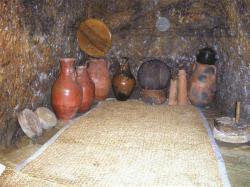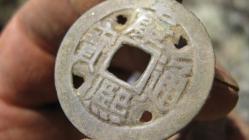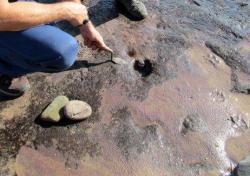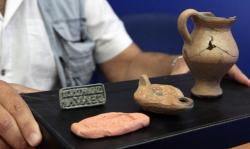INSTITUT SUPERIEUR D'ANTHROPOLOGIE
INSTITUTE OF ANTHROPOLOGY
ONLINE COURSES / COURS A DISTANCE
FALL TERM : OCTOBER 2015
REGISTER NOW
TURQUIE –  Bayburt - Foreign and domestic tourists are continuing to flock to the famed “Underground City” claimed to be around 3,000 years old in the southeastern province of Bayburt. The ancient figures on the walls, in particular, draw great attention from visitors. The underground city was brought to light in 1988 during construction work in the Aydıntepe district, 25 kilometers outside of Bayburt. The district mayor and museum directorate decided to extend the visitor path to 850 meters after excavations in 2008. In the first eight months of 2015, around 25,000 foreign and domestic tourists visited the city. The work at the underground site has not involved any building materials and the city was engraved in a single section of bedrock consisting of tuff, some 2.5 meters under the ground. The underground city consists of rooms, large areas, corridors, ventilating slits and lamp holes in conic shapes, along with a castle and galleries with vaulted covers. The archaeological works have unearthed 4,000-year-old tombs and 3,000-year-old wall figures, showing how ancient the settlement is. The underground city is thought to have been used by Christians, particularly for sheltering from danger, with a number of rooms, a kitchen and a pool for water.
Bayburt - Foreign and domestic tourists are continuing to flock to the famed “Underground City” claimed to be around 3,000 years old in the southeastern province of Bayburt. The ancient figures on the walls, in particular, draw great attention from visitors. The underground city was brought to light in 1988 during construction work in the Aydıntepe district, 25 kilometers outside of Bayburt. The district mayor and museum directorate decided to extend the visitor path to 850 meters after excavations in 2008. In the first eight months of 2015, around 25,000 foreign and domestic tourists visited the city. The work at the underground site has not involved any building materials and the city was engraved in a single section of bedrock consisting of tuff, some 2.5 meters under the ground. The underground city consists of rooms, large areas, corridors, ventilating slits and lamp holes in conic shapes, along with a castle and galleries with vaulted covers. The archaeological works have unearthed 4,000-year-old tombs and 3,000-year-old wall figures, showing how ancient the settlement is. The underground city is thought to have been used by Christians, particularly for sheltering from danger, with a number of rooms, a kitchen and a pool for water.
http://www.hurriyetdailynews.com/tourists-flock-to-3000-year-old-underground-city-in-bayburt.aspx?pageID=238&nid=88188&NewsCatID=375
USA –  Californie - The science team aboard Nautilus, a research vessel operated by the Ocean Exploration Trust, recently explored the wreckage of the USS Macon, an aircraft-carrier dirigible operated by the U.S. Navy that crashed off the coast of California and sank in 1935. The researchers used remotely-operated vehicles to explore the remains of the airship and the four Sparrowhawk biplanes it carried. The Macon, which was the last lighter-than-air aircraft carrier used by the Navy, was on its way back from a mission when it ran into stormy weather. A tail fin was sheared off the ship, and the crew was unable to maintain control. Two crewmen were lost, but 74 others survived. The scientists took 360-degree video of one of the biplanes, and measured the corroded parts of one airplane wing. They also measured how much sediment had built up since the 1935 crash. The ROV also retrieved a piece of an aluminum girder for research use. The team’s data will be compared with data collected in a 2006 expedition to help determine how fast the wreck is corroding. “We’re really extending the life of this airship and her biplanes and documenting the past 80 years she spent under water, which is the majority of her life,” said NOAA archaeologist Megan Lickliter-Mundon, during the live broadcast.
Californie - The science team aboard Nautilus, a research vessel operated by the Ocean Exploration Trust, recently explored the wreckage of the USS Macon, an aircraft-carrier dirigible operated by the U.S. Navy that crashed off the coast of California and sank in 1935. The researchers used remotely-operated vehicles to explore the remains of the airship and the four Sparrowhawk biplanes it carried. The Macon, which was the last lighter-than-air aircraft carrier used by the Navy, was on its way back from a mission when it ran into stormy weather. A tail fin was sheared off the ship, and the crew was unable to maintain control. Two crewmen were lost, but 74 others survived. The scientists took 360-degree video of one of the biplanes, and measured the corroded parts of one airplane wing. They also measured how much sediment had built up since the 1935 crash. The ROV also retrieved a piece of an aluminum girder for research use. The team’s data will be compared with data collected in a 2006 expedition to help determine how fast the wreck is corroding. “We’re really extending the life of this airship and her biplanes and documenting the past 80 years she spent under water, which is the majority of her life,” said NOAA archaeologist Megan Lickliter-Mundon, during the live broadcast.
VIDEO = https://www.youtube.com/watch?v=Y1xi_3_wnlU
http://www.avweb.com/avwebflash/news/Research-Team-Explores-Airship-Wreck-224824-1.html?
CANADA –  Toronto - The remnants of a centuries-old Toronto market were unearthed as during a pre-construction archaeological dig. Brick walls, sewer pipes and part of a pier were found during the precautionary dig near the site of the current St. Lawrence Market. The remnants are believed to date back to the 1830s, 1850s and 1900s, when Front Street marked the city's waterfront. The area is being examined by archaeologists, as is customary in Toronto when there's a chance that historical items may be unearthed during the construction process. During the dig, crews found evidence from the 1831, 1851 and 1904 markets that stood on the same site. The property has been home to markets since at least 1803, the City of Toronto said in a statement on Tuesday, but the first permanent structure was built in 1831. The brick building was used as both a town hall and marketplace at the time. It was destroyed in a fire in 1849, and rebuilt in 1851. "The finds include foundation piers from the 1831 building, a large arched flagstone sewer relating to either the 1831 or 1851 development, and the original, pre-development ground surface preserved within the interior courtyard of the 1831 building," the statement said.
Toronto - The remnants of a centuries-old Toronto market were unearthed as during a pre-construction archaeological dig. Brick walls, sewer pipes and part of a pier were found during the precautionary dig near the site of the current St. Lawrence Market. The remnants are believed to date back to the 1830s, 1850s and 1900s, when Front Street marked the city's waterfront. The area is being examined by archaeologists, as is customary in Toronto when there's a chance that historical items may be unearthed during the construction process. During the dig, crews found evidence from the 1831, 1851 and 1904 markets that stood on the same site. The property has been home to markets since at least 1803, the City of Toronto said in a statement on Tuesday, but the first permanent structure was built in 1831. The brick building was used as both a town hall and marketplace at the time. It was destroyed in a fire in 1849, and rebuilt in 1851. "The finds include foundation piers from the 1831 building, a large arched flagstone sewer relating to either the 1831 or 1851 development, and the original, pre-development ground surface preserved within the interior courtyard of the 1831 building," the statement said.
http://toronto.ctvnews.ca/remnants-of-1800s-market-found-under-st-lawrence-development-1.2552756
CANADA –  Yukon - A 17th-century Chinese coin found during an archeological dig in Yukon is on display in Whitehorse. In 2011, archeologists found the coin on Kwanlin Dun First Nation land northwest of Carmacks. At the time, it was the third coin of its kind found in the territory, and the second one found on Kwanlin Dun land. The coin was estimated to have been minted between 1667 and 1671. Sean Smith, a Kwanlin Dun councillor, says the find is evidence of the First Nation's contact with the Chinese market via Russian and coastal Tlingit traders. "The significance is also ... the history of my people being in this area, to hunt to live, to fish, to trade with other people and to develop relationships with other people that were coming in and out of this land." Archeologists also found microblades, bone tools, and other artifacts dating back 8,000 years at the same site where the coin was found.
Yukon - A 17th-century Chinese coin found during an archeological dig in Yukon is on display in Whitehorse. In 2011, archeologists found the coin on Kwanlin Dun First Nation land northwest of Carmacks. At the time, it was the third coin of its kind found in the territory, and the second one found on Kwanlin Dun land. The coin was estimated to have been minted between 1667 and 1671. Sean Smith, a Kwanlin Dun councillor, says the find is evidence of the First Nation's contact with the Chinese market via Russian and coastal Tlingit traders. "The significance is also ... the history of my people being in this area, to hunt to live, to fish, to trade with other people and to develop relationships with other people that were coming in and out of this land." Archeologists also found microblades, bone tools, and other artifacts dating back 8,000 years at the same site where the coin was found.
http://www.cbc.ca/news/canada/north/17th-century-chinese-coin-found-in-yukon-on-display-at-kwanlin-dun-centre-1.3218892
ROYAUME UNI –  Druridge Bay - Fresh evidence showing what life may have been like at Druridge Bay as long as 7,000 years ago, has been unearthed by an archaeologist. Barry Mead has discovered a second set of well-preserved hoofprints, possibly made by an ancient breed of wild cattle, on the beach near his Cresswell home. Eighteen months ago, he had found more animal and human prints preserved on the beach in a peat bed, which had been exposed by an exceptionally high tide.
Druridge Bay - Fresh evidence showing what life may have been like at Druridge Bay as long as 7,000 years ago, has been unearthed by an archaeologist. Barry Mead has discovered a second set of well-preserved hoofprints, possibly made by an ancient breed of wild cattle, on the beach near his Cresswell home. Eighteen months ago, he had found more animal and human prints preserved on the beach in a peat bed, which had been exposed by an exceptionally high tide.
http://www.northumberlandgazette.co.uk/news/local-news/ancient-hoofprints-found-on-northumberland-beach-1-7449305?
BULGARIE –  Perperikon - A number of artifacts from the Roman period, including a clay lamp with a depiction of the ancient deity Eros, have been discovered by the team of archaeologist Nikolay Ovcharov during theexcavations of the ancient and medieval rock city of Perperikon. Speaking at a news conference, Ovcharov has presented to the public some of his latest finds fromPerperikon, the rock city in the Eastern Rhodope Mountains in Southern Bulgaria, which was a major settlement in the Prehistory, Antiquity, and Middle Ages, reports the Bulgarian state news agency BTA. The double wick clay lamp discovered in Perperikon features an image of the winged god Eros together with images of vine friezes, and geometrical elements. “All of this allows us to date this lamp to the end of the 2nd and the beginning of the 3rd century AD, and even to determine its place of origin – Asia Minor (Anatolia), and most probably the region of Ephesus,” Ovcharov explains noting the trade among the provinces of the Roman Empire at the time. Other artifacts from the same time period – the 2nd-3rd century AD – which have been discovered recently by Ovcharov in Perperikon include a wine cup and a bronze seal. The seal features the name of Dimitrius Celluli, with the archaeologists hypothesizing that the man in question was a local craftsman producing luxury chairs or maybe even sedan chairs (litter) for aristocrats. This hypothesis is based on the second word in the name which is translated as meaning “a small chair”, even though the archaeologists do not rule out the possibility that it was just a family name which did not signify an occupation. Another recent find from Perperikon are several signs, one of them featuring the name “Amonius”.This is believed to have been the name of a Roman military veteran who settled in Perperikon in the 2nd-3rd century.
Perperikon - A number of artifacts from the Roman period, including a clay lamp with a depiction of the ancient deity Eros, have been discovered by the team of archaeologist Nikolay Ovcharov during theexcavations of the ancient and medieval rock city of Perperikon. Speaking at a news conference, Ovcharov has presented to the public some of his latest finds fromPerperikon, the rock city in the Eastern Rhodope Mountains in Southern Bulgaria, which was a major settlement in the Prehistory, Antiquity, and Middle Ages, reports the Bulgarian state news agency BTA. The double wick clay lamp discovered in Perperikon features an image of the winged god Eros together with images of vine friezes, and geometrical elements. “All of this allows us to date this lamp to the end of the 2nd and the beginning of the 3rd century AD, and even to determine its place of origin – Asia Minor (Anatolia), and most probably the region of Ephesus,” Ovcharov explains noting the trade among the provinces of the Roman Empire at the time. Other artifacts from the same time period – the 2nd-3rd century AD – which have been discovered recently by Ovcharov in Perperikon include a wine cup and a bronze seal. The seal features the name of Dimitrius Celluli, with the archaeologists hypothesizing that the man in question was a local craftsman producing luxury chairs or maybe even sedan chairs (litter) for aristocrats. This hypothesis is based on the second word in the name which is translated as meaning “a small chair”, even though the archaeologists do not rule out the possibility that it was just a family name which did not signify an occupation. Another recent find from Perperikon are several signs, one of them featuring the name “Amonius”.This is believed to have been the name of a Roman military veteran who settled in Perperikon in the 2nd-3rd century.
http://archaeologyinbulgaria.com/2015/09/07/archaeologist-finds-clay-lamp-with-eros-other-roman-age-artifacts-in-ancient-and-medieval-rock-city-perperikon/